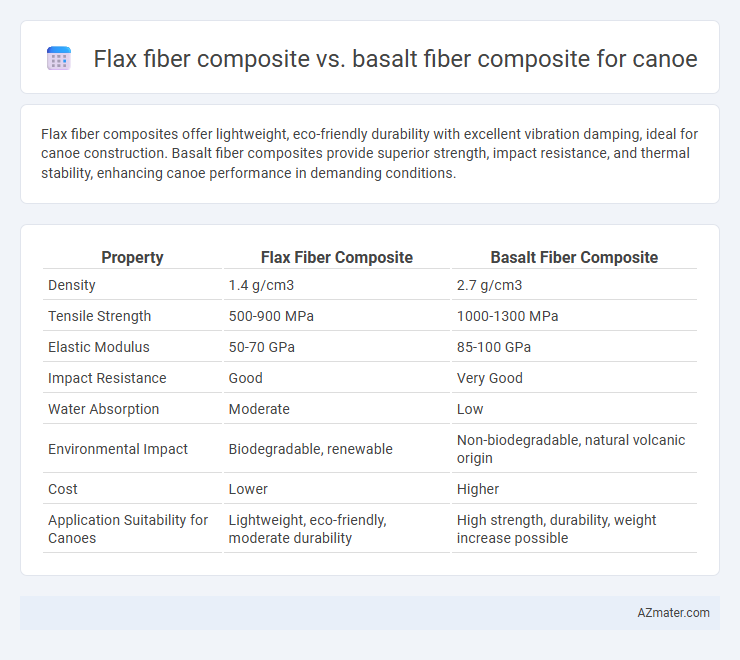Flax fiber composites offer lightweight, eco-friendly durability with excellent vibration damping, ideal for canoe construction. Basalt fiber composites provide superior strength, impact resistance, and thermal stability, enhancing canoe performance in demanding conditions.
Table of Comparison
| Property | Flax Fiber Composite | Basalt Fiber Composite |
|---|---|---|
| Density | 1.4 g/cm3 | 2.7 g/cm3 |
| Tensile Strength | 500-900 MPa | 1000-1300 MPa |
| Elastic Modulus | 50-70 GPa | 85-100 GPa |
| Impact Resistance | Good | Very Good |
| Water Absorption | Moderate | Low |
| Environmental Impact | Biodegradable, renewable | Non-biodegradable, natural volcanic origin |
| Cost | Lower | Higher |
| Application Suitability for Canoes | Lightweight, eco-friendly, moderate durability | High strength, durability, weight increase possible |
Introduction to Natural Fiber Composites in Canoe Manufacturing
Flax fiber composites offer lightweight, sustainable alternatives to traditional materials in canoe manufacturing, providing excellent tensile strength and enhanced flexibility. Basalt fiber composites, derived from volcanic rock, deliver superior impact resistance and durability while maintaining environmental benefits over synthetic fibers. Both natural fiber composites reduce carbon footprints and improve performance, making them increasingly popular choices for eco-friendly canoe construction.
Overview of Flax Fiber Composites
Flax fiber composites offer a lightweight, sustainable alternative to traditional materials, featuring high tensile strength and excellent vibration damping suitable for canoe construction. Their natural origin contributes to lower environmental impact and enhanced biodegradability compared to synthetic fibers like basalt. Flax composites also exhibit good fatigue resistance and flexibility, making them ideal for crafting durable, eco-friendly canoe hulls.
Overview of Basalt Fiber Composites
Basalt fiber composites are derived from volcanic rock, offering superior mechanical strength, high thermal stability, and excellent resistance to chemical and environmental corrosion compared to flax fiber composites. These composites provide enhanced durability and impact resistance, making them ideal for high-performance canoe construction where longevity and structural integrity are critical. The eco-friendly nature of basalt fibers, combined with their ability to be processed without harmful solvents, also positions them as a sustainable alternative in advanced composite materials.
Mechanical Properties: Flax vs Basalt Fiber Composites
Flax fiber composites exhibit lower tensile strength and modulus compared to basalt fiber composites, making basalt more suitable for high-stress applications in canoes. Basalt fibers provide superior impact resistance and stiffness, enhancing durability and handling in demanding water conditions. Flax fibers offer better vibration damping and environmental sustainability but at the cost of reduced mechanical performance relative to basalt composites.
Weight Comparison: Flax Fiber vs Basalt Fiber Canoes
Flax fiber composites offer significantly lower density compared to basalt fiber composites, resulting in lighter canoes ideal for enhanced maneuverability and easier transport. Basalt fiber composites, while heavier, provide greater strength-to-weight ratios, making them suitable for durability under harsh conditions. The weight difference between flax and basalt fiber canoes typically ranges from 10% to 20%, with flax offering a distinct advantage in lightweight performance.
Durability and Environmental Resistance
Flax fiber composites exhibit moderate durability with good impact resistance but are more susceptible to moisture absorption and UV degradation compared to basalt fiber composites. Basalt fiber composites offer superior environmental resistance, including higher resistance to chemicals, heat, and prolonged UV exposure, making them more durable for long-term use in watercraft like canoes. The choice between flax and basalt fiber composites impacts the canoe's lifespan and maintenance requirements, with basalt providing enhanced durability in harsh environmental conditions.
Sustainability and Eco-Friendliness
Flax fiber composite offers superior sustainability with its renewable, biodegradable natural fibers and low-energy processing, significantly reducing environmental impact compared to synthetic alternatives. Basalt fiber composite, derived from abundant volcanic rock, provides excellent recyclability and durability but involves higher energy consumption during production. Both materials contribute to eco-friendly canoe manufacturing, yet flax fiber's lower carbon footprint and biodegradability position it as the more sustainable choice.
Cost Analysis: Material and Production
Flax fiber composite offers cost advantages over basalt fiber composite due to lower raw material prices and simpler processing requirements, reducing overall production expenses for canoe manufacturing. Basalt fiber composites involve higher material costs and energy-intensive production processes, increasing the final product price. Flax fiber's renewable nature and compatibility with standard resin systems contribute to its economic efficiency in sustainable canoe construction.
Performance in Real-World Canoeing Conditions
Flax fiber composites offer excellent vibration damping and lightweight properties, enhancing maneuverability and comfort in real-world canoeing conditions. Basalt fiber composites provide superior tensile strength and impact resistance, making them more durable against rocks and harsh water environments. Both materials perform well, but basalt fiber composites excel in longevity and structural integrity, while flax composites prioritize eco-friendly, flexible performance.
Conclusion: Choosing the Right Fiber Composite for Canoes
Flax fiber composites offer excellent sustainability, lightweight properties, and good vibration damping, making them ideal for eco-conscious canoe builders prioritizing natural materials. Basalt fiber composites provide superior strength, durability, and resistance to impact and thermal stress, suitable for high-performance canoes requiring enhanced structural integrity. Selecting between flax and basalt fiber composites depends on balancing environmental impact, mechanical performance, and specific use-case demands in canoe construction.

Infographic: Flax fiber composite vs Basalt fiber composite for Canoe
 azmater.com
azmater.com